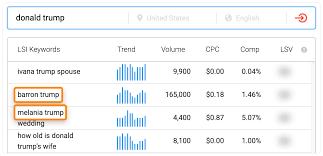LSI SEO: Enhancing Search Engine Optimization with Latent Semantic Indexing
Search Engine Optimization (SEO) is a crucial component of any successful online marketing strategy. One advanced technique that has gained popularity in recent years is Latent Semantic Indexing (LSI) SEO. LSI SEO involves optimizing web content not just for specific keywords, but also for related terms and concepts that search engines use to understand the context of a page.
Traditional SEO practices focus on using exact match keywords to improve a website’s search engine rankings. While keywords are still important, search engines like Google have become more sophisticated in analyzing content for relevance and quality. This is where LSI comes into play.
Latent Semantic Indexing is a mathematical method used to identify the relationship between words and concepts within a body of text. By incorporating LSI into SEO strategies, website owners can create content that is not only keyword-rich but also semantically relevant.
So how does LSI SEO work in practice? Instead of simply repeating the same keyword multiple times throughout a webpage, LSI encourages the use of synonyms, related terms, and variations of the main keyword. This helps search engines understand the overall theme of the content and its relevance to user queries.
By implementing LSI SEO techniques, website owners can improve their chances of ranking higher in search engine results pages (SERPs) for a wider range of related queries. This approach also helps to create more natural and engaging content for human readers, as it avoids keyword stuffing and focuses on providing valuable information.
Incorporating LSI into your SEO strategy requires careful research and planning. Tools like Google’s Keyword Planner and semantic analysis software can help identify relevant terms to include in your content. It’s important to strike a balance between optimizing for keywords and incorporating LSI principles to ensure your content ranks well while remaining informative and engaging.
In conclusion, Latent Semantic Indexing (LSI) SEO offers website owners an effective way to enhance their search engine optimization efforts by focusing on semantic relevance and context. By utilizing LSI techniques alongside traditional keyword optimization practices, businesses can improve their online visibility, attract more organic traffic, and provide valuable content that resonates with both users and search engines.
8 Essential Tips for Mastering LSI SEO to Boost Your Website’s Performance
- Understand the concept of Latent Semantic Indexing (LSI) and how it relates to SEO.
- Create high-quality, relevant content that incorporates LSI keywords naturally.
- Use tools like LSIGraph to identify related keywords for your content.
- Avoid keyword stuffing and focus on providing value to users with your content.
- Optimize your website structure and internal linking to enhance LSI signals.
- Monitor and analyze the performance of your LSI-optimized content using SEO tools.
- Stay updated on search engine algorithms and trends related to LSI SEO.
- Experiment with different LSI strategies to see what works best for your website.
Understand the concept of Latent Semantic Indexing (LSI) and how it relates to SEO.
To improve your SEO strategy, it is essential to grasp the concept of Latent Semantic Indexing (LSI) and its significance in optimizing web content. LSI focuses on the relationship between words and concepts within a piece of text, allowing search engines to better understand the context and relevance of a webpage. By incorporating LSI into your SEO efforts, you can create content that not only targets specific keywords but also includes related terms and synonyms to enhance semantic relevance. Understanding LSI enables you to develop more comprehensive and contextually rich content that resonates with both search engines and users, ultimately boosting your website’s visibility and ranking in search results.
Create high-quality, relevant content that incorporates LSI keywords naturally.
To effectively leverage LSI SEO, it is essential to create high-quality, relevant content that seamlessly incorporates LSI keywords in a natural manner. By focusing on producing valuable and engaging content that includes related terms and synonyms, website owners can enhance their search engine rankings and improve the overall user experience. This approach not only helps search engines better understand the context of the content but also ensures that readers receive informative and well-rounded information that meets their needs. By prioritizing quality and relevance in content creation while integrating LSI keywords organically, businesses can successfully boost their online visibility and attract a broader audience.
Use tools like LSIGraph to identify related keywords for your content.
To enhance your LSI SEO strategy, consider utilizing tools such as LSIGraph to identify related keywords that can enrich your content. By leveraging LSIGraph, you can uncover a variety of semantically related terms and concepts that can help you create more comprehensive and contextually relevant content. Integrating these related keywords into your writing not only improves the semantic relevance of your content but also increases the likelihood of ranking higher in search engine results pages for a wider range of queries. Incorporating tools like LSIGraph into your SEO workflow can streamline the process of identifying and implementing LSI keywords, ultimately boosting the effectiveness of your optimization efforts.
Avoid keyword stuffing and focus on providing value to users with your content.
To enhance your SEO strategy with LSI principles, it is crucial to avoid keyword stuffing and prioritize delivering value to users through your content. Instead of repeatedly inserting the same keywords unnaturally, focus on creating informative and engaging content that addresses the needs and interests of your target audience. By incorporating related terms and synonyms in a meaningful way, you can improve the relevance and quality of your content while also satisfying search engine algorithms. This user-centric approach not only boosts your search engine rankings but also fosters a positive user experience, ultimately driving more organic traffic to your website.
Optimize your website structure and internal linking to enhance LSI signals.
To enhance LSI signals in your SEO strategy, it is crucial to optimize your website structure and internal linking. By organizing your website in a logical and hierarchical manner, you can create a clear pathway for search engine crawlers to understand the relationships between different pages and topics. Implementing strategic internal linking helps establish contextual connections between related content, strengthening the semantic relevance of your website. This approach not only improves user navigation but also provides search engines with valuable signals about the thematic focus of your site, ultimately boosting its overall visibility and ranking potential.
Monitor and analyze the performance of your LSI-optimized content using SEO tools.
To maximize the effectiveness of your LSI-optimized content, it is essential to monitor and analyze its performance using SEO tools. By tracking key metrics such as organic traffic, keyword rankings, and user engagement, you can gain valuable insights into how well your content is resonating with both search engines and your target audience. SEO tools provide data-driven feedback that allows you to identify areas for improvement, refine your LSI strategy, and ultimately enhance the overall visibility and impact of your website in search results. Regular monitoring and analysis ensure that your LSI SEO efforts remain aligned with current trends and best practices, helping you stay ahead of the competition in the ever-evolving digital landscape.
Stay updated on search engine algorithms and trends related to LSI SEO.
Staying updated on search engine algorithms and trends related to LSI SEO is crucial for maintaining a competitive edge in the ever-evolving digital landscape. Search engines regularly update their algorithms to provide more relevant and accurate search results, including the way they interpret and rank content based on latent semantic indexing. By staying informed about these changes and trends, website owners can adapt their SEO strategies to align with best practices and maximize their online visibility. Keeping abreast of the latest developments in LSI SEO ensures that your content remains optimized for semantic relevance, helping you stay ahead of the competition and attract quality organic traffic to your website.
Experiment with different LSI strategies to see what works best for your website.
To optimize your website’s search engine performance using LSI SEO, it is essential to experiment with various LSI strategies to determine which ones yield the best results for your specific content and target audience. By testing different approaches, such as incorporating synonyms, related terms, and variations of keywords, you can identify the most effective tactics that enhance the semantic relevance of your content. Through continuous experimentation and analysis, you can refine your LSI SEO strategy to maximize your website’s visibility and engagement with search engines and users alike.




